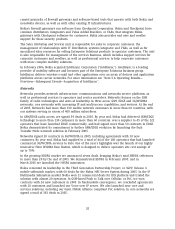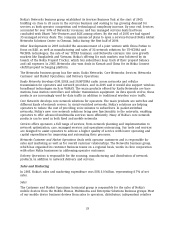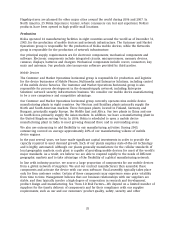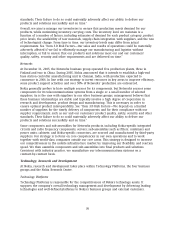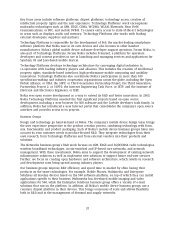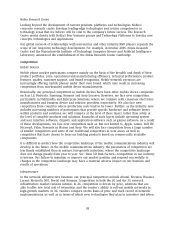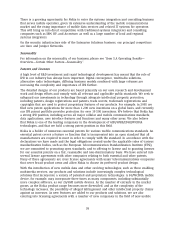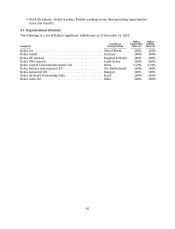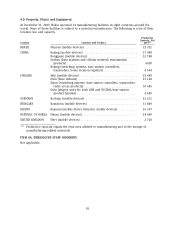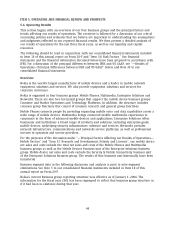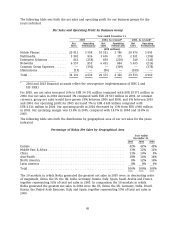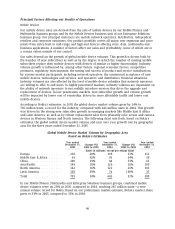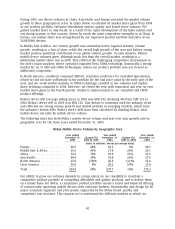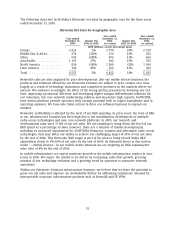Nokia 2005 Annual Report Download - page 43
Download and view the complete annual report
Please find page 43 of the 2005 Nokia annual report below. You can navigate through the pages in the report by either clicking on the pages listed below, or by using the keyword search tool below to find specific information within the annual report.Other countries also have direct and indirect regulations that affect our business. Changes in the
regulations or their interpretation, whether relating to our device, network, or other products or
business processes, could affect our business. For example, the implementation of new
technological or legal requirements could impact products, wireless services and solutions,
manufacturing or distribution processes, and could affect the timing of product introductions, the
cost of production, and the commercial success of products. Our net sales and results of operations
could be adversely affected by export controls, tariffs or other fees or levies imposed on our
products, as well as by environmental, product safety and security and other regulations that
affect the export, import, pricing or cost of our products and solutions, as well as new services
related to our products. We are in a continuous dialogue with regulatory bodies through our
experts, industry associations and lobbyists.
Corporate Responsibility
As market leader and a top global brand, our impact on society comes with responsibilities that go
beyond providing useful, safe, secure and quality products. During 2005, we made progress in a
number of key areas.
In anticipation of upcoming EU environmental legislation on the restriction of certain hazardous
substances, or RoHS, Nokia introduced its first two fully-compliant products. This was well in
advance of the July 1, 2006 deadline, when the new directive restricting the use of lead, cadmium,
mercury, chromium and two flame retardants in electronic products takes effect.
Nokia’s first global stakeholder engagement event, in October 2005, brought together 160
participants representing civil society, the public sector, academia, and a range of businesses. The
aim of the event was to provide a platform for people to give frank and honest views on
important issues, including the importance of multi-sector cooperation, youth care, mobile
communications for development, and corporate responsibility reporting.
Following an update of our Code of Conduct, Nokia’s Group Executive Board launched a
companywide Code of Conduct awareness campaign focused on an e-learning training and
discussion platform. The initial September to December 2005 phase reached a sub-target of close to
30 000 Nokia employees, with a further 15 000 targeted by April 2006. Nokia’s Code of Conduct,
which has been translated into 25 languages, explains how our employees must carry out their
work and comply with ethical and legal standards.
Employee Development
Fundamental to our success is the ‘‘Nokia Way’’ for all our people. The Nokia Way is a philosophy
of attracting and retaining the best people and maintaining continuous renewal. It centers around
four core values: customer satisfaction, respect, achievement and renewal. We believe these are
critical in order for a global organization such as Nokia to work effectively.
Nokia’s employee-value proposition framework remains strong. The four fundamentals of the
proposition, together with the elements encompassed by each of them, are as follows:
•Nokia Way and Values: fact-based management/value-based leadership, code of conduct,
equal opportunities, diversity, internal communications and feedback channels.
•Extensive performance-based rewarding: base pay, equity-based instruments, comprehensive
incentive system through Nokia ‘‘Connecting People’’ bonuses and individual, team and
project/program incentive payments.
•Professional and personal growth: career development, job rotation, training and
performance management.
41



